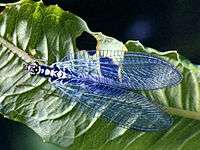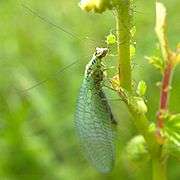Chrysopa perla
| Chrysopa perla | |
|---|---|
.jpg) | |
| Scientific classification | |
| Kingdom: | Animalia |
| Clade: | Euarthropoda |
| Class: | Insecta |
| Order: | Neuroptera |
| Family: | Chrysopidae |
| Genus: | Chrysopa |
| Species: | C. perla |
| Binomial name | |
| Chrysopa perla | |
| Synonyms[1] | |
|
List
| |
Chrysopa perla, known commonly as the green lacewing, is an insect species belonging to the family Chrysopidae (subfamily Chrysopinae).
Distribution
This widespread species is present in most of Europe[2] and in temperate zones of Asia.[3][4]
Habitat
These insects prefer cool and shady areas, mainly in deciduous woods, wet forests, woodland edges, hedge rows, scrubby grassland and shrubs.[5][3]
Description
The adults reach 10–12 millimetres (0.39–0.47 in) of length, with a wingspan of 25–30 millimetres (0.98–1.18 in).[4][5] The basic coloration of the body is green. Wings are blue-green with black veins. They turn pale yellow during the winter. Several black markings are present on the head, the thorax and below the abdomen.[4] The second antennal segment is black.[3] This species is rather similar to Chrysopa dorsalis, showing an oval pale spot between the eyes, which is roundish in C. perla.[3]
Biology
Adults can be encountered from May through August.[5] They are fearsome predators, primarily feeding on aphids,[4] occasionally on flower nectar.[3]
The females usually lay eggs near aphid colonies.[4] Larvae are predators, mainly feeding on Aphididae, Coccidae species and caterpillars (Pieris brassicae, Autographa gamma).[5] The adult insects hibernate in winter.[4]
Gallery
 Dorsal view
Dorsal view- Female. Side view
 Wing detail
Wing detail Eating aphids
Eating aphids
References
- ↑ Catalogue of the world
- ↑ Fauna europaea
- 1 2 3 4 5 Nature Spot
- 1 2 3 4 5 6 Insektenbox (in German)
- 1 2 3 4 J.K. Lindsey Commanster
Further reading
- Chrysopa perla p. 417 in Hagen, K.S; Mills, N.J; Gordh, G; McMurtry, J.A (1999). "Terrestrial Arthropod Predators of Insect and Mite Pests". In Bellows, Thomas S.; Fisher, T.W. Handbook of Biological Control. pp. 383–503. doi:10.1016/B978-012257305-7/50063-1. ISBN 978-0-12-257305-7.
- Plant, Colin W. (1994). Provisional atlas of the lacewings and allied insects (Neuroptera, Megaloptera, Raphidioptera and Mecoptera) of Britain and Ireland. ISBN 978-1-870393-18-8.
- Flint, H. M; Salter, S. S; Walters, S (1979). "Caryophyllene: An Attractant for the Green Lacewing". Environmental Entomology. 8 (6): 1123–1125. doi:10.1093/ee/8.6.1123.
- James, David G (2003). "Field Evaluation of Herbivore-Induced Plant Volatiles as Attractants for Beneficial Insects: Methyl Salicylate and the Green Lacewing, Chrysopa nigricornis". Journal of Chemical Ecology. 29 (7): 1601–1609. doi:10.1023/A:1024270713493.
- Bond, Alan B (1980). "Optimal foraging in a uniform habitat: The search mechanism of the green lacewing". Animal Behaviour. 28: 10–19. doi:10.1016/S0003-3472(80)80003-0.
- Romeis, Jörg; Dutton, Anna; Bigler, Franz (2004). "Bacillus thuringiensis toxin (Cry1Ab) has no direct effect on larvae of the green lacewing Chrysoperla carnea (Stephens) (Neuroptera: Chrysopidae)". Journal of Insect Physiology. 50 (2–3): 175–183. doi:10.1016/j.jinsphys.2003.11.004.
- Knowledge Encyclopedia Animal!. Dorling Kindersley. 2016-10-03. p. 45. ISBN 978-0-241-28964-8.
External links
- Uniprot

